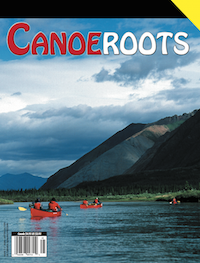Canoeists can solo arrow-straight into a headwind, eddy out of class IV rapids, execute quick and efficient portages, and pull cheese soufflés from reflector ovens. But ask us to catch a fish and we’re most often skunked.
Our wilderness wanderings take us where brook trout, walleye, char and grayling fin hungrily beneath the Kevlar. But clad in Gore-Tex and wielding bent shafts, canoeists see paddling as primary. Some flirt with fishing but their efforts are frivolous at best. It’s too often a case of fishing in the wrong place, at the wrong time, with inappropriate equipment.
Adding fishing to the canoe tripping agenda is not difficult. On remote rivers or lakes, the right moves will provide instant gratification. A first step is determining the type of fish to expect. Studying route descriptions and talking to outfitters or natural resources personnel help us to fine-tune our gear and ensure that the season is open and we’re properly licensed.
Proven tackle will depend on the species holding in our destination waters. Throughout Canada the most common choices oscillate between warm-water species like bass, pike, perch and walleye, and those who prefer colder water, like trout and char.
Live bait is effective for both sets of species. Worms are the lowest-maintenance, needing only to be kept cool in a small container of moss. Worms can be fished on their own, with a single hook weighted with split shot, or used to sweeten artificial lures.
A canoeist’s tackle box should include variety and still slide easily into an outside pocket of a pack. Include a few diving minnow-shaped crank baits. Adjust the size to the fish you expect to catch—three to six inches in length will do for most situations.
Include eigth-ounce to half-ounce jig heads and a fist full of soft plastic twister tails. Scented tails in white, black, and chartreuse are effective with or without live bait.
Throw in a selection of mid-sized spinners and a couple silver and gold spoons. If pike are prevalent, a few steel leaders will prevent the loss of lures to these toothy predators.
Remote systems often provide more fish than we could possibly eat. Bending the barbs down on our hooks allows for gentle handling and quick release of most of what we catch.
Organize the gear in a small plastic box, saving enough room for essentials like needle-nose pliers for unhooking fish, a fillet knife and Zip-loc bags for the fillets.
A medium-action five- or six-footer is a good all-purpose rod for canoe tripping. Teamed with a mid-sized spinning reel holding about 100 metres of eight- to twelve-pound monofilament line, the unit should be able to handle most game fish encountered on inland lakes and rivers. Two-piece rods can be broken down and easily stowed. A few short lengths of small-diameter shock cord attach rods securely to thwarts and seats during portages or when running whitewater.
Even in the most prolific waters, fish are not everywhere and we must learn to recognize where to concentrate our efforts. In rivers, the base of falls and rapids point to the most obvious haunts. Oxygen-rich waters churn in deep holes and most species will hold somewhere within the pool. Bends in the river can also mean deep-water eddies and increased current. The same is true where narrowing shorelines funnel the flow through deep channels.
In lakes, hot spots are not so obvious. Look for features that stand out from the rest of the lake. Shoals, rock piles, extended points, steep drop-offs or weed edges will all hold fish.
Wind and current tend to make anchoring a canoe the most effective way to fish the hot spots of lakes and rivers. A strong mesh bag filled with rocks makes a great anchor that can be emptied for the portage trail. From an anchored position we can slowly work jigs along bottom, still fish with hook and worm, or cast spoons, spinners and crank baits over the shoals and weed edges of lakes or across a river’s current.
In rivers we can avoid the uncertainty of anchoring in strong flows by fishing from shore. In lakes we can opt for trolling when the wind and waves conspire against dropping the hook. In fact, tossing a line out and trolling while paddling is an effective search technique that unwittingly draws our lure over mid-lake features that hold fish.
Beware: Angling can insidiously become the prime focus of a wilderness outing, adding a new and time-consuming dimension to a canoe trip. Satiating the desire to angle means taking the time to fish during peak periods of morning and evening, as well as trying that irresistible spot we may pass during the day.
Of course not all paddlers will be enchanted by the fusion of paddling and angling. Those less stricken should avoid conflict by sharing a canoe with a like-minded partner. While the anglers work the wilderness waters, the paddlers can forge ahead to set up camp. When the cheese soufflé emerges from the reflector oven, it will be the perfect complement to a meal of fresh fillets.
James Smedley is the recipient of several national writing awards. He lives, writes, photographs and canoe-angles in northern Ontario.




